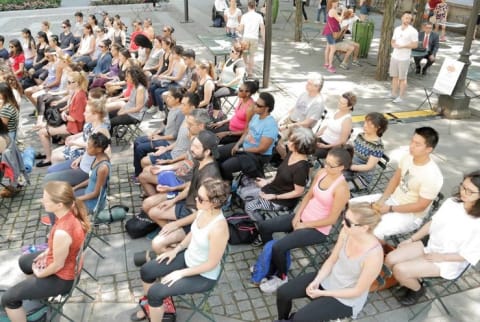Advertisement
4 Ways To Take Your Meditation Practice To The Next Level


As meditation is growing in popularity, free group meditations are popping up all over the place, especially in New York. Large-scale events like The Big Quiet, organize group meditations in public spaces throughout the city. Ziva Meditation, my studio, offers free group guided sessions in Bryant Park.
I’m frequently asked, “What’s the importance of group meditation? Why should I go to one if I already meditate on my own?”
The answer: Meditating with others takes things to a whole new level. Besides the obvious benefit of not being able to jump on your phone midway through, the are some scientific benefits that I've listed below. No matter where you are in your journey as a meditator, attending a group meditation can be a valuable asset to your practice.
Here are four ways group meditation can take things to the next level:
1. It can deepen your practice.
Even though our eyes are closed, there are mirror neurons in our brains. A mirror neuron is a type of brain cell that “sees” the actions of someone else’s mirror neurons, and then mimics or "mirrors" them.
So when we meditate in a group, simultaneously de-exciting our nervous systems, these neurons are stimulated in a synergistic manner. This can feel great — not only for you, but for the people in the surrounding areas. Mallika Chopra notes, “While meditation is fundamentally about self-exploration, the coherence from meditating with others makes it personally and socially more powerful.”
Think of it like a collective laundering of consciousness. Imagine that all of the people meditating in a room together share a collective consciousness or group mind. Now imagine that group mind as a trampoline: if you throw a single bowling ball onto a trampoline, it can only bend so far. But the more bowling balls that you add to the trampoline, the deeper it will bend. Our consciousness works in the same way; the more meditators in one space, the deeper the dive can be.
2. It can have an effect on the outside world, too.
In addition to affecting the minds of the individuals in the physical space, there is a theory that meditation in numbers can have a significant effect on collective consciousness. Let's say one percent of the population in a given area is practicing meditation — crime rates in the area may drop correspondingly.
Although further research is needed in order to empirically prove that this theory is accurate (or imply causality), it is a powerful notion to think that meditating in groups could have a positive effect on the surrounding social climate.
3. It super-charges your personal meditation practice.
If you need a little extra personal motivation, meditating in a group will also refresh and change your individual practice so that even when you leave the group meditation, your individual meditations will feel like they’ve been invigorated. Additionally, it can help revamp your commitment to your practice if you’re prone to getting distracted by environmental stimuli or cutting your meditations short.
Making the effort to attend a group meditation is like making the effort to go to an exercise class at the gym — the more you do it, the better you feel, and the more likely you are to continue the practice consistently on your own time.
4. It can be combined with yoga for even more benefits!
While we commonly know asana with reference to a pose or movement when applied to the practice of yoga, its ancient Sanskrit meaning also translates to the word, seat. So of course there's Chair Pose (Utkatasana), but why are all the rest of the poses called asana? Because yoga is designed to prepare your body for meditation — a seated meditation. Doing yoga just prior to meditation, therefore, can add yet another layer of relaxation to your practice.
You have a lot to gain from group meditation, and little to lose. Watch the short video below to learn more about the power and importance of group meditation.
Photo and video courtesy of the author